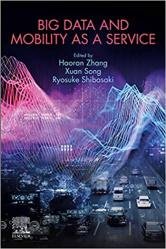Big Data and Mobility as a Service
- Добавил: literator
- Дата: 15-10-2021, 02:01
- Комментариев: 0
 Название: Big Data and Mobility as a Service
Название: Big Data and Mobility as a ServiceАвтор: Haoran Zhang, Xuan Song
Издательство: Elsevier
Год: 2022
Страниц: 308
Язык: английский
Формат: pdf (true)
Размер: 62.7 MB
Big Data and Mobility as a Service explores MaaS platforms that can be adaptable to the ever-evolving mobility environment. It looks at multi-mode urban crowd data to assess urban mobility characteristics, their shared transportation potential, and their performance conditions and constraints. The book analyzes the roles of multimodality, travel behavior, urban mobility dynamics and participation. Combined with insights on using Big Data to analyze market and policy decisions, this book is an essential tool for urban transportation management researchers and practitioners.
Big Data is made up of larger, complex datasets that originate from increasingly new sources of data. These datasets are so massive that the abilities of traditional data processing software are insufficient to manage them. Nevertheless, these massive volumes of data can be used to address business problems that would not have been tackled before. A simple definition of Big Data organized around big data's three Vs could be large volumes of data that contain immense variety and are generated at increasing velocity. Recently, six other Vs and one C have been added to define the truthfulness and meaningfulness of data as veracity, infrequency as validity, extracting value from the collected data, replicability in the form of visualizations, processability in a virtual cloud platform, data variability, and complexity, purely in computation form.
Data organization and storage systems were developed as well. Hadoop, an open-source framework created specifically to store and analyze large datasets, was developed around the same year. This development of open-source frameworks such as Hadoop, Spark, and others was essential for the growth of big data because they make data storage cheaper and enhance the ease of engaging with big datasets.
Nevertheless, the volume of Big Data has been at an all-time high, as is the dependency on it for decision making. Users of the system are still generating significant amounts of data. However, it is not just humans that are engaging with systems. Evolution in smartphone and sensor technology now allows devices to communicate through the Internet of Things (IoT) network. Besides, advancements in devices and communication network systems have eased data gathering for various indicators and drawing performance insights. Moreover, the emergence of artificial intelligence and machine learning has churned out diversity and cross-operability across various platforms.
Furthermore, cloud computing has expanded Big Data possibilities in truly elastic scalability. Such scalability is of critical importance in analyzing and supporting demands in services. We focus on this aspect of Big Data to solve challenges that hinder future development, particularly in understanding the emerging area of MaaS.
- Summarizes current fundamental MaaS technologies
- Shows how to utilize anonymous big data for transportation analysis and problem-solving
- Illustrates, with data-enabled shared transportation service examples from different countries, the similarities and differences within a global urban mobility framework
Скачать Big Data and Mobility as a Service
Внимание
Уважаемый посетитель, Вы зашли на сайт как незарегистрированный пользователь.
Мы рекомендуем Вам зарегистрироваться либо войти на сайт под своим именем.
Уважаемый посетитель, Вы зашли на сайт как незарегистрированный пользователь.
Мы рекомендуем Вам зарегистрироваться либо войти на сайт под своим именем.
Информация
Посетители, находящиеся в группе Гости, не могут оставлять комментарии к данной публикации.
Посетители, находящиеся в группе Гости, не могут оставлять комментарии к данной публикации.
